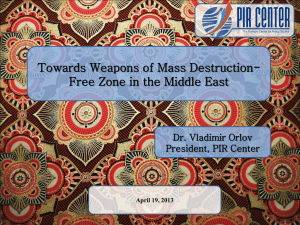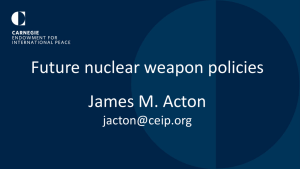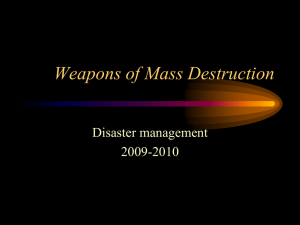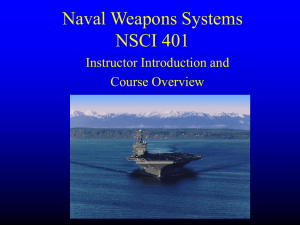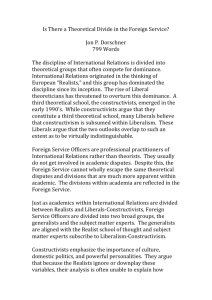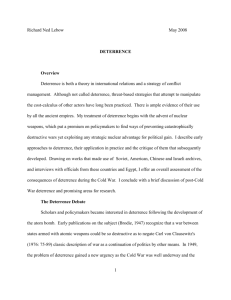War - WW Norton & Company
advertisement
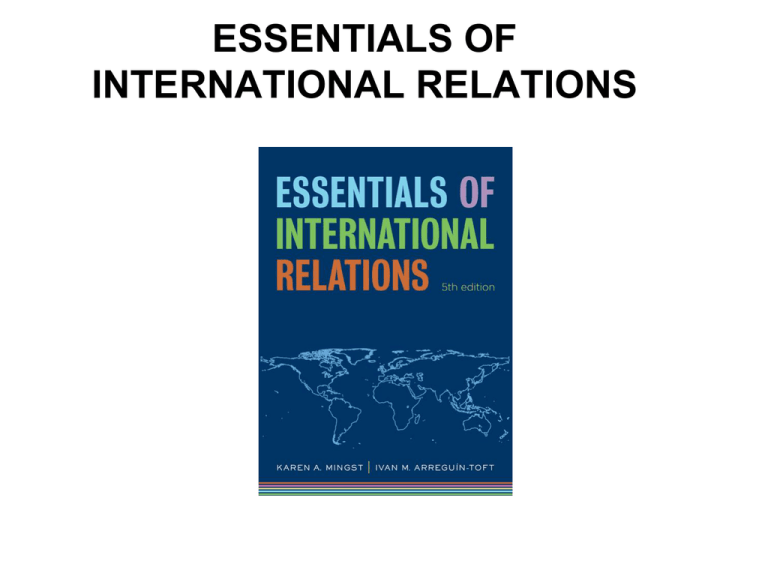
ESSENTIALS OF INTERNATIONAL RELATIONS Chapter 8 War and Strife War: The Data • 14,500 armed struggles in history, depending on how we define war • Approximately 3.5 billion deaths • Since 1816, between 224 and 559 international and intrastate wars • War incidence has declined after 1991. • Number of battlefield deaths has declined by 80% since 1991. Is War Inevitable? Realist Answers • War can be managed but never eliminated due to human nature. • States exist in an anarchic system, with no overarching authority to provide security or settle disputes. • States are thus insecure and must rely on self-help to find security. • Insecurity can lead to the “security dilemma.” Irony of the Security Dilemma • As one state seeks to ameliorate its insecurity, it seeks power. • Once state A gains power, it inadvertently makes state B insecure. • State B then seeks more power, which it might not have otherwise done. • As state B gains power, state A again becomes insecure and seeks more power. Irony of the Security Dilemma • RESULTS: Vicious circle of power accumulation Permanent condition of tension Liberals: Is War Inevitable? • Anarchy is a structural restraint. • States can learn to cooperate because of self-interest in the benefits of peace. • International institutions act as cooperation enablers by reducing transition costs and increasing cheating costs—“cooperative competition.” Liberals: Is War Inevitable? • Benefits of cooperation will push more states to become democratic. • More liberal, democratic states = more peace Radicals: Transcending War • Capitalism turns human nature toward greed and relentless, destructive competition. • The state supports repressive forces of capitalism at the expense of the majority of people, both domestically and worldwide (imperialism). • War will exist so long as capitalism exists. • War can be eliminated through the triumph of socialism, which fosters sharing of resources and labor. Constructivists: Reducing War • Threats are socially constructed. • Implications of material objects are socialized as threatening. • Different types of socialization can lead to different outcomes. Example: United Kingdom versus Iran owning nuclear weapons Causes of War Individual Level of Analysis • Individual(s)—realists and liberals Personal characteristics of leaders Misperceptions Communications failures Causes of War Individual Level of Analysis • Individual(s)—realists and liberals Characteristics of the masses • St. Augustine—act of self-preservation • Niebuhr—war is inherent to humans • War as the unusual event Causes of War State Level of Analysis • State and society—liberal and radical views • Struggles over internal structures and characteristics of states cause war. • Liberals—democracy restrains leaders, provides outlets for opposing viewpoints. Causes of War State Level of Analysis • Disagreement about effect of capitalist structure Liberals say those states avert war, prefer trade. Radicals say this leads to competition among social groups, stagnation, collapse, or the search for external markets in diversionary war. International System as the Cause of War • International system—realist and radical views • Anarchy, no final arbiter of disputes • System in state of nature (Hobbes) • Realists—war is caused by states challenging international hierarchy due to Changing state capabilities Changing distribution of power among states International System as the Cause of War • Radicals—dominant states need to expand, leading to war over resources. Explaining Iraq’s Invasion of Kuwait • Individual Level Saddam Hussein was insecure and ruthless, misinterpreted U.S. intentions, and miscalculated Saudi Arabia’s interests. • State Level Iraq had historic claims on Kuwait and it was in Iraq’s national interest to seize Kuwaiti oil fields; authoritarian governments are more likely to choose war as the means to settle disputes. Explaining Iraq’s Invasion of Kuwait • International Level Iraq believed invasion would not invoke a response, UN Security Council lacked the cohesion to act, and Arab League would not condemn other Arab states’ actions. War over South Ossetia, 2008 • Individuals Promises of Saakashvili election—sought to bolster Georgian pride Putin promised force and aggressive diplomacy • State/Society: no democracy War over South Ossetia, 2008 • International Russia sought to keep out competitors and maintain its position as the regional power. Georgia sought the greater power’s protection. Categorizing Wars • Interstate war—between states, as they have recognizable leadership and locations and formal militaries • Intrastate/civil war—between factions within state over control of territory or institutions; many have international repercussions; can last decades; high human costs Categorizing Wars • Total war—massive loss of life, widespread destruction; many participants, including multiple powers; all available weapons utilized; civilians and military targeted • Limited war—may be limited by goals pursued, type of weapons used, amount of resources used; targets Explaining the Decline of Total War • Memories of World War II • Nuclear war too costly • Development of security communities Realists: rise of U.S. hegemony Liberals: democratic peace, economic interdependence, international organizations Constructivists: people socialized into attitudes, values, and beliefs in peace How Wars Are Fought • Conventional warfare—weapons can be limited in time and space; precise targeting; easily available Problems: chemical weapons; indiscriminate • Weapons of mass destruction (WMD)—nuclear, chemical, biological Problems: radiation, indiscriminate How Wars Are Fought • Unconventional warfare—ignores conventions of war Guerilla warfare, revolutionary guerilla warfare, asymmetric conflicts, terrorism Going Nuclear: The View from Iran • Iran has an “inalienable right” to develop nuclear energy technology for peaceful purposes via Nuclear Nonproliferation Treaty. • Oil and gas will run out and refining capacity is very limited; thus, an alternative energy source is needed. • But Iran’s legitimate security threats from neighboring countries (Pakistan, Afghanistan, Iraq, Israel) plus fear of U.S. invasion may push nuclear development. Going Nuclear: The View from Iran • Iran’s decision was propelled by U.S. invasion of Iraq and its identification of Iran as part of “axis of evil,” even after post-9/11 intelligence information suggested otherwise. • Based on historic U.S. interference in Iran’s domestic politics, the population supports government policy. Asymmetric Conflicts: Battle Tactics • Asymmetric warfare—between parties of unequal strength; weaker party seeks to neutralize opponent strengths by exploiting weaknesses • Guerilla war—a “small war” often inspired by nationalism • Revolutionary guerilla war—defeat technologically superior and well-equipped foe by exploiting weaknesses; civilians protect guerillas; traditional warfare concepts eliminated; win hearts and minds of the people Terrorism as Asymmetric Warfare • Elements of terrorism Act is political by nature or intent Committed by non-state actors Combatant or non-combatant targets Use unconventional means at unpredictable places and intervals Terrorism as Asymmetric Warfare • Motivated by political, religious, or economic goals • Seek to instill fear to attain goals Terrorism’s Transformation since the 1990s • Attacks have become more lethal. • Choice of weapons has become more diverse. • More efficient infrastructure for terrorist networks Example: electronic money laundering; funding via illegal activities; Internet recruiting Terrorism’s Transformation since the 1990s • Wider range of groups: nationalist, radical religious, neo-Nazi, left-wing and right-wing • State sponsors, such as Cuba, Iran, North Korea Responses to Terrorism • International level: conclusion of 12 conventions designed to punish hijackers; protect infrastructure, diplomats, and nuclear materials; and block financial transfers • State level: information sharing among states; monitoring of financial flows; USA PATRIOT Act Just War Tradition— Jus ad Bellum Just conditions for going into war • Just cause: self-defense; defense of others; massive violation of human rights • Declaration of intent by appropriate authority • Have intentions of ending abuses and establishing a just peace Just War Tradition— Jus ad Bellum Just conditions for going into war • Must have exhausted all other alternatives • Forces must be removed quickly after objectives are achieved. Just War Tradition— Jus ad Bellum Just conduct in war • Distinguish between combatants and noncombatants • Noncombatants protected from harm • Violence proportionate to ends • Undue human suffering avoided • Individual responsibility for actions taken Banning Landmines— Evolution of Norms • International campaign began in 1992 • Spearheaded by non-governmental organizations (NGOs); coordinator was Jody Williams • Argued weapons are indiscriminate and have an unfair destructive impact on innocent noncombatants • From arms control issue to human rights issue • Constructivists: demonstrates impact of norms and socialization in altering behavior of state and nonstate actors Key Questions about Humanitarian Intervention • How massive do human rights abuses have to be before intervention is just? • Who decides when a humanitarian intervention is necessary? The United Nations? A coalition within the region? Any powerful state? • Is the humanitarian intervention occurring for legitimate reasons or as an excuse to achieve other objectives? Key Questions about Humanitarian Intervention • Do states have a responsibility to protect (R2P)? • How can some interventions be justified while other situations cannot? Can Military Intervention Stop Genocide? • YES—Genocide Convention approves state action Force is the sufficiently fast response Warns others Coupled with humanitarian aid, most effective Can Military Intervention Stop Genocide? • NO—Rarely involve state’s national interests Complex organization, costly Can be misinterpreted as neocolonialism Nearby countries better informed but unprepared Not effective deterrent, nonmilitary aid more effective over long term Realist Approaches 1: Managing Insecurity Balance of Power—states, as rational actors, make decisions to increase their own capabilities and undermine those of others • Use of alliances to balance power both internationally and regionally (external balancing) • Increase military and economic capabilities to counter potential threats (internal balancing) Realist Approaches 1: Managing Insecurity Balance of Power • Emphasis on relative versus absolute gains • Most important technique for realists Problems of Managing Insecurity with Balance of Power • The balance of power favors the status quo. • When fundamental change occurs, the appropriate response may provide balance. • When power transitions are occurring, balance of power is problematic. Changes in NATO with Decline of the Soviet Threat • Increase in membership to 28 states 2009: Croatia, Albania • Enhance operational capabilities with new technology • Create a rapid reaction force for crises • Diversify tasks • Engage in out-of-area operations NATO’s Successful Transformation • Realists—achieved relative gains over Russia and increased Western security • Liberals—strengthened democracy in postcommunist states; institutional membership increased security, improved economic and diplomatic cooperation, and opened the door to other institutions; institutionalized dialogue with Russia • Constructivists—confirmed independent identity of post-communist states; shows acceptance of, and means to, further norms Realist Approaches 2: Managing Insecurity through Deterrence • Goal Prevent the outbreak of war by credible a threat of the use of force. • Assumptions Decision makers are rational. The threat of destruction from nuclear warfare is too great. Alternatives to war are available. Deterrence in Practice • States must build arsenals for a credible threat. If an alliance, such as NATO, is part of that threat, the alliance must prove its cohesion. • Information about the threat must be communicated. • Leaders must be able to make rational decisions. Deterrence in the Twenty-first Century • The rise of nonstate actors decreases the possibility that deterrence will work. • Nonstate actors do not hold territory, so a threat to destroy territory is not effective. • The presence of flexible, geographically spread groups makes eliminating networks difficult. Deterrence in the Twenty-first Century • Willingness to use suicide terrorism undermines deterrence logic • U.S. nuclear primacy may mean deterrence against the United States is impossible. Liberals Managing Security 1: Collective Security Assumptions of Collective Security • Wars are caused by aggressive states. • Aggressors must be stopped. • Aggressors are easily identified. • Aggressors are always morally wrong. • Aggressors know ahead of time that the international community will act against them. Weakness of Collective Security in Practice • There is lack of commitment by some nations to act in concert. • Never works against permanent members of UN Security Council due to veto power • Difficulty of identifying aggressor • It’s difficult to determine whether the aggressor is always wrong. Arms Control and Disarmament Assumptions • Fewer weapons means greater security. • Regulate arms proliferation (arms control) or reduce amount of arms and types of weapons (disarmament) • Costs of security dilemma are reduced. • Major agreements include bilateral, regional, and global treaties covering conventional, nuclear, chemical, and biological weapons. Nuclear Nonproliferation Treaty (NPT ) • Signed in 1968; in force since 1970;189 signatories • States without nuclear weapons agree not to acquire or develop them. • States with nuclear weapons promise not to transfer technology to non-nuclear states and to eventually dismantle their own. • International Atomic Energy Agency (IAEA) is “guardian” of the NPT, by means such as inspection teams and information gathering. Limitations of NPT • Nuclear states outside the treaty Cuba, India, Israel, Pakistan • Inspections by IAEA can be difficult to conduct and inspectors have been asked to leave. • States can pull out of the treaty: North Korea • Liberals acknowledge complete disarmament of all types of weapons is unlikely (due to cheaters), but pursue incremental disarmament. Challenges to State-Centered View of Security • More intrastate violence and advancing technology means that contain war are becoming less likely. • Role of more private actors Piracy Outsourcing security tasks to private companies “Soldier-employees” do not always have national ties to “state-employer.” Rethinking Security Are we moving from state (national security) to human security? • Human security includes Economic and social well-being Literacy Adequate health care Clean environment General personal safety

